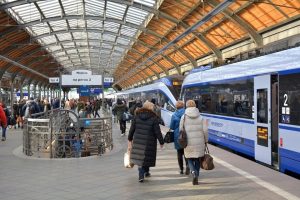 2021 is intended to be the European year of rail which will be a great support to deliver the Green Deal objectives in the transport field, the EC announced on 4 March. The proposal will be needed to be adopted by the European Parliament and the Council.
2021 is intended to be the European year of rail which will be a great support to deliver the Green Deal objectives in the transport field, the EC announced on 4 March. The proposal will be needed to be adopted by the European Parliament and the Council.
Following this proposal, a series of events, campaigns and initiatives in 2021 will promote rail as a sustainable, innovative and safe mode of transport.
“There’s no doubt that railway transport means huge benefits in most areas: sustainability, safety, even speed, once it’s organised and engineered according to 21st century principles. But there’s also something more profound about railways: they connect the EU together not only in physical terms. Setting up a coherent and functional network across all Europe is an exercise in political cohesion. The European Year of Rail is not a random event. It comes at an appropriate time, when the EU needs this kind of collective undertaking,” Commissioner for Transport Adina Vălean said.
Next year, the modernisation of the railway transport will enter full swing as the European authorities want to highly support it to “make it a more popular alternative to less sustainable transport modes”. 2021 marks the first full year in which the rules agreed under the Fourth Railway Package will be implemented throughout the EU, the 20th anniversary of the first Railway Package, the 175th anniversary of the first ever rail link between two capitals (Paris-Brussels), as well as 40 years of TGV and 30 years of ICE.
The international arts festival Europalia has already chosen railways as their 2021 theme and will be an active contributor to the wide range of activities taking place throughout the European year of rail.
The proposal comes as the EC has proposed its Green Deal to achieve climate neutrality by 2050. As the transport sector accounts for a quarter of the EU’s greenhouse gas emissions, the sector will play a crucial role in achieving this target and has been set the objective of reducing its emissions by 90% by 2050. In supporting the development of a sustainable and smart mobility, a substantial part of the 75% of inland freight carried today by road should shift onto rail and inland waterways. Rail has to play a significant role in accelerating the reduction in transport emissions, as one of the most environmentally friendly and energy-efficient transport modes. Railways continuously reduced CO2 emissions since 1990 despite increasing transport volumes. By 2016, it represented only 0.5% of the CO2 emissions from all transport modes. In addition, rail only accounts for 2% of total Union energy consumption in transport, while it carried 11.2% of freight and 6.6% of passengers of all transport modes in 2016. Rail has decreased its energy consumption between 1990-2016 and increasingly uses renewable energy sources.
Share on:



